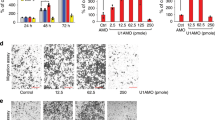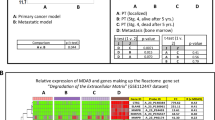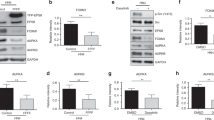Abstract
Nuclear factor (erythroid-derived 2)-like 2 (Nrf2) expression is deregulated in many cancers. Genetic and biochemical approaches coupled with functional assays in cultured cells were used to explore the consequences of Nrf2 repression. Nrf2 suppression by Keap1-directed ubiquitylation or the expression of independent short hairpin RNA (shRNA)/siRNA sequences enhanced cellular levels of reactive oxygen species, Smad-dependent tumor cell motility and growth in soft agar. Loss of Nrf2 was accompanied by concomitant Smad linker region/C-terminus phosphorylation, induction of the E-cadherin transcriptional repressor Slug and suppression of the cell–cell adhesion protein E-cadherin. Ectopic expression of the wildtype but not dominant-negative Nrf2 suppressed the activity of a synthetic transforming growth factor-β1-responsive CAGA-directed luciferase reporter. shRNA knock-down of Nrf2 enhanced the activity of the synthetic CAGA reporter, as well as the expression of the endogenous Smad target gene plasminogen activator inhibitor-1. Finally, we found that Nrf2/Smad3/Smad4 formed an immunoprecipitable nuclear complex. Thus, loss of Nrf2 increased R-Smad phosphorylation and R-Smad signaling, supporting the hypothesis that loss of Nrf2 in an oncogenic context-dependent manner can enhance cellular plasticity and motility, in part by using transforming growth factor-β/Smad signaling.
This is a preview of subscription content, access via your institution
Access options
Subscribe to this journal
Receive 50 print issues and online access
$259.00 per year
only $5.18 per issue
Buy this article
- Purchase on Springer Link
- Instant access to full article PDF
Prices may be subject to local taxes which are calculated during checkout








Similar content being viewed by others
References
Barve A, Khor TO, Nair S, Reuhl K, Suh N, Reddy B et al. (2009). Gamma-tocopherol-enriched mixed tocopherol diet inhibits prostate carcinogenesis in TRAMP mice. Int J Cancer 124: 1693–1699.
Beer DG, Kardia SL, Huang CC, Giordano TJ, Levin AM, Misek DE et al. (2002). Gene-expression profiles predict survival of patients with lung adenocarcinoma. Nat Med 8: 816–824.
Biswas S, Guix M, Rinehart C, Dugger TC, Chytil A, Moses HL et al. (2007). Inhibition of TGF-beta with neutralizing antibodies prevents radiation-induced acceleration of metastatic cancer progression. J Clin Invest 117: 1305–1313.
Brown SL, Sekhar KR, Rachakonda G, Sasi S, Freeman ML . (2008). Activating transcription factor 3 is a novel repressor of the nuclear factor erythroid-derived 2-related factor 2 (Nrf2)-regulated stress pathway. Cancer Res 68: 364–368.
Calonge MJ, Massague J . (1999). Smad4/DPC4 silencing and hyperactive Ras jointly disrupt transforming growth factor-beta antiproliferative responses in colon cancer cells. J Biol Chem 274: 33637–33643.
Cao J, Schulte J, Knight A, Leslie NR, Zagozdzon A, Bronson R et al. (2009). Prdx1 inhibits tumorigenesis via regulating PTEN/AKT activity. Embo J 28: 1505–1517.
Chakraborty AK, Ueda M, Mishima Y, Ichihashi M . (1992). Intracellular glutathione and its metabolizing enzyme activities in a metastatic variant melanoma cell line. Melanoma Res 2: 315–319.
Chan K, Lu R, Chang JC, Kan YW . (1996). NRF2, a member of the NFE2 family of transcription factors, is not essential for murine erythropoiesis, growth, and development. Proc Natl Acad Sci USA 93: 13943–13948.
Chen X, Cheung ST, So S, Fan ST, Barry C, Higgins J et al. (2002). Gene expression patterns in human liver cancers. Mol Biol Cell 13: 1929–1939.
Chung CH, Parker JS, Karaca G, Wu J, Funkhouser WK, Moore D et al. (2004). Molecular classification of head and neck squamous cell carcinomas using patterns of gene expression. Cancer Cell 5: 489–500.
Coulouarn C, Factor VM, Thorgeirsson SS . (2008). Transforming growth factor-beta gene expression signature in mouse hepatocytes predicts clinical outcome in human cancer. Hepatology 47: 2059–2067.
Frohlich DA, McCabe MT, Arnold RS, Day ML . (2008). The role of Nrf2 in increased reactive oxygen species and DNA damage in prostate tumorigenesis. Oncogene 27: 4353–4362.
Greenburg G, Hay ED . (1982). Epithelia suspended in collagen gels can lose polarity and express characteristics of migrating mesenchymal cells. J Cell Biol 95: 333–339.
Grinberg AV, Kerppola T . (2003). Both Max and TFE3 cooperate with Smad proteins to bind the plasminogen activator inhibitor-1 promoter, but they have opposite effects on transcriptional activity. J Biol Chem 278: 11227–11236.
Hayashi A, Suzuki H, Itoh K, Yamamoto M, Sugiyama Y . (2003). Transcription factor Nrf2 is required for the constitutive and inducible expression of multidrug resistance-associated protein 1 in mouse embryo fibroblasts. Biochem Biophys Res Commun 310: 824–829.
Hendrix ND, Wu R, Kuick R, Schwartz DR, Fearon ER, Cho KR . (2006). Fibroblast growth factor 9 has oncogenic activity and is a downstream target of Wnt signaling in ovarian endometrioid adenocarcinomas. Cancer Res 66: 1354–1362.
Hirayama A, Yoh K, Nagase S, Ueda A, Itoh K, Morito N et al. (2003). EPR imaging of reducing activity in Nrf2 transcriptional factor-deficient mice. Free Radic Biol Med 34: 1236–1242.
Homma S, Ishii Y, Morishima Y, Yamadori T, Matsuno Y, Haraguchi N et al. (2009). Nrf2 enhances cell proliferation and resistance to anticancer drugs in human lung cancer. Clin Cancer Res 15: 3423–3432.
Hong F, Sekhar KR, Freeman ML, Liebler DC . (2005). Specific patterns of electrophile adduction trigger Keap1 ubiquitination and Nrf2 activation. J Biol Chem 280: 31768–31775.
Huber BE, Thorgeirsson SS . (1987). Analysis of c-myc expression in a human hepatoma cell line. Cancer Res 47: 3414–3420.
Inoue Y, Itoh Y, Abe K, Okamoto T, Daitoku H, Fukamizu A et al. (2007). Smad3 is acetylated by p300/CBP to regulate its transactivation activity. Oncogene 26: 500–508.
Jinnin M, Ihn H, Tamaki K . (2006). Characterization of SIS3, a novel specific inhibitor of Smad3, and its effect on transforming growth factor-beta1-induced extracellular matrix expression. Mol Pharmacol 69: 597–607.
Kamata H, Honda S, Maeda S, Chang L, Hirata H, Karin M . (2005). Reactive oxygen species promote TNFalpha-induced death and sustained JNK activation by inhibiting MAP kinase phosphatases. Cell 120: 649–661.
Kang Y, Chen CR, Massague J . (2003). A self-enabling TGFbeta response coupled to stress signaling: Smad engages stress response factor ATF3 for Id1 repression in epithelial cells. Mol Cell 11: 915–926.
Katoh Y, Itoh K, Yoshida E, Miyagishi M, Fukamizu A, Yamamoto M . (2001). Two domains of Nrf2 cooperatively bind CBP, a CREB binding protein, and synergistically activate transcription. Genes Cells 6: 857–868.
Kobayashi A, Kang MI, Okawa H, Ohtsuji M, Zenke Y, Chiba T et al. (2004). Oxidative stress sensor Keap1 functions as an adaptor for Cul3-based E3 ligase to regulate proteasomal degradation of Nrf2. Mol Cell Biol 24: 7130–7139.
Komatsu M, Kurokawa H, Waguri S, Taguchi K, Kobayashi A, Ichimura Y et al. (2010). The selective autophagy substrate p62 activates the stress responsive transcription factor Nrf2 through inactivation of Keap1. Nat Cell Biol 12: 213–223.
Kusano Y, Horie S, Shibata T, Satsu H, Shimizu M, Hitomi E et al. (2008). Keap1 regulates the constitutive expression of GST A1 during differentiation of Caco-2 cells. Biochemistry 47: 6169–6177.
Kwak MK, Itoh K, Yamamoto M, Sutter TR, Kensler TW . (2001). Role of transcription factor Nrf2 in the induction of hepatic phase 2 and antioxidative enzymes in vivo by the cancer chemoprotective agent, 3H-1, 2-dimethiole-3-thione. Mol Med 7: 135–145.
Lee DF, Kuo HP, Liu M, Chou CK, Xia W, Du Y et al. (2009). KEAP1 E3 ligase-mediated downregulation of NF-kappaB signaling by targeting IKKbeta. Mol Cell 36: 131–140.
Liberati NT, Datto MB, Frederick JP, Shen X, Wong C, Rougier-Chapman EM et al. (1999). Smads bind directly to the Jun family of AP-1 transcription factors. Proc Natl Acad Sci USA 96: 4844–4849.
Liu J, Hinkhouse MM, Sun W, Weydert CJ, Ritchie JM, Oberley LW et al. (2004). Redox regulation of pancreatic cancer cell growth: role of glutathione peroxidase in the suppression of the malignant phenotype. Hum Gene Ther 15: 239–250.
Lo SC, Hannink M . (2006). PGAM5, a Bcl-XL-interacting protein, is a novel substrate for the redox-regulated Keap1-dependent ubiquitin ligase complex. J Biol Chem 281: 37893–37903.
Loignon M, Miao W, Hu L, Bier A, Bismar TA, Scrivens PJ et al. (2009). Cul3 overexpression depletes Nrf2 in breast cancer and is associated with sensitivity to carcinogens, to oxidative stress, and to chemotherapy. Mol Cancer Ther 8: 2432–2440.
Luo J, Solimini NL, Elledge SJ . (2009). Principles of cancer therapy: oncogene and non-oncogene addiction. Cell 136: 823–837.
Mates JM, Segura JA, Alonso FJ, Marquez J . (2008). Intracellular redox status and oxidative stress: implications for cell proliferation, apoptosis, and carcinogenesis. Arch Toxicol 82: 273–299.
Matsuzaki K, Kitano C, Murata M, Sekimoto G, Yoshida K, Uemura Y et al. (2009). Smad2 and Smad3 phosphorylated at both linker and COOH-terminal regions transmit malignant TGF-beta signal in later stages of human colorectal cancer. Cancer Res 69: 5321–5330.
Matsuzawa A, Ichijo H . (2008). Redox control of cell fate by MAP kinase: physiological roles of ASK1-MAP kinase pathway in stress signaling. Biochem Biophys Acta 1780: 1325–1336.
Mithani SK, Balch GC, Shiou SR, Whitehead RH, Datta PK, Beauchamp RD . (2004). Smad3 has a critical role in TGF-beta-mediated growth inhibition and apoptosis in colonic epithelial cells. J Surg Res 117: 296–305.
Moi P, Chan K, Asunis I, Cao A, Kan YW . (1994). Isolation of NF-E2-related factor 2 (Nrf2), a NF-E2-like basic leucine zipper transcriptional activator that binds to the tandem NF-E2/AP1 repeat of the beta-globin locus control region. Proc Natl Acad Sci USA 91: 9926–9930.
Muller N, Reinacher-Schick A, Baldus S, van Hengel J, Berx G, Baar A et al. (2002). Smad4 induces the tumor suppressor E-cadherin and P-cadherin in colon carcinoma cells. Oncogene 21: 6049–6058.
Nioi P, Nguyen T . (2007). A mutation of Keap1 found in breast cancer impairs its ability to repress Nrf2 activity. Biochem Biophys Res Commun 362: 816–821.
Nogueira V, Park Y, Chen CC, Xu PZ, Chen ML, Tonic I et al. (2008). Akt determines replicative senescence and oxidative or oncogenic premature senescence and sensitizes cells to oxidative apoptosis. Cancer Cell 14: 458–470.
Ohta T, Iijima K, Miyamoto M, Nakahara I, Tanaka H, Ohtsuji M et al. (2008). Loss of Keap1 function activates Nrf2 and provides advantages for lung cancer cell growth. Cancer Res 68: 1303–1309.
Padmanabhan B, Tong KI, Ohta T, Nakamura Y, Scharlock M, Ohtsuji M et al. (2006). Structural basis for defects of Keap1 activity provoked by its point mutations in lung cancer. Mol Cell 21: 689–700.
Peinado H, Olmeda D, Cano A . (2007). Snail, Zeb and bHLH factors in tumour progression: an alliance against the epithelial phenotype? Nat Rev Cancer 7: 415–428.
Radisky DC, Levy DD, Littlepage LE, Liu H, Nelson CM, Fata JE et al. (2005). Rac1b and reactive oxygen species mediate MMP-3-induced EMT and genomic instability. Nature 436: 123–127.
Ramos-Gomez M, Kwak MK, Dolan PM, Itoh K, Yamamoto M, Talalay P et al. (2001). Sensitivity to carcinogenesis is increased and chemoprotective efficacy of enzyme inducers is lost in nrf2 transcription factor-deficient mice. Proc Natl Acad Sci USA 98: 3410–3415.
Safina AF, Varga AE, Bianchi A, Zheng Q, Kunnev D, Liang P et al. (2009). Ras alters epithelial-mesenchymal transition in response to TGFbeta by reducing actin fibers and cell-matrix adhesion. Cell Cycle 8: 284–298.
Sarsour EH, Venkataraman S, Kalen AL, Oberley LW, Goswami PC . (2008). Manganese superoxide dismutase activity regulates transitions between quiescent and proliferative growth. Aging Cell 7: 405–417.
Sekhar KR, Crooks PA, Sonar VN, Friedman DB, Chan JY, Meredith MJ et al. (2003). NADPH oxidase activity is essential for Keap1/Nrf2-mediated induction of GCLC in response to 2-indol-3-yl-methylenequinuclidin-3-ols. Cancer Res 63: 5636–5645.
Shibata T, Ohta T, Tong KI, Kokubu A, Odogawa R, Tsuta K et al. (2008). Cancer related mutations in NRF2 impair its recognition by Keap1-Cul3 E3 ligase and promote malignancy. Proc Natl Acad Sci USA 105: 13568–13573.
Shiou SR, Singh AB, Moorthy K, Datta PK, Washington MK, Beauchamp RD et al. (2007). Smad4 regulates claudin-1 expression in a transforming growth factor-beta-independent manner in colon cancer cells. Cancer Res 67: 1571–1579.
Singh A, Boldin-Adamsky S, Thimmulappa RK, Rath SK, Ashush H, Coulter J et al. (2008). RNAi-mediated silencing of nuclear factor erythroid-2-related factor 2 gene expression in non-small cell lung cancer inhibits tumor growth and increases efficacy of chemotherapy. Cancer Res 68: 7975–7984.
Singh A, Misra V, Thimmulappa RK, Lee H, Ames S, Hoque MO et al. (2006). Dysfunctional KEAP1-NRF2 interaction in non-small-cell lung cancer. PLoS Med 3: e420.
Song CZ, Siok TE, Gelehrter TD . (1998). Smad4/DPC4 and Smad3 mediate transforming growth factor-beta (TGF-beta) signaling through direct binding to a novel TGF-beta-responsive element in the human plasminogen activator inhibitor-1 promoter. J Biol Chem 273: 29287–29290.
Stacy DR, Ely K, Massion PP, Yarbrough WG, Hallahan DE, Sekhar KR et al. (2006). Increased expression of nuclear factor E2 p45-related factor 2 (NRF2) in head and neck squamous cell carcinomas. Head Neck 28: 813–818.
Strachan GD, Ostrow LA, Jordan-Sciutto KL . (2005). Expression of the fetal Alz-50 clone 1 protein induces apoptotic cell death. Biochem Biophys Res Commun 336: 490–495.
Sun Y, Oberley LW, Elwell JH, Sierra-Rivera E . (1989). Antioxidant enzyme activities in normal and transformed mouse liver cells. Int J Cancer 44: 1028–1033.
Szatrowski TP, Nathan CF . (1991). Production of large amounts of hydrogen peroxide by human tumor cells. Cancer Res 51: 794–798.
Thuault S, Valcourt U, Petersen M, Manfioletti G, Heldin CH, Moustakas A . (2006). Transforming growth factor-beta employs HMGA2 to elicit epithelial-mesenchymal transition. J Cell Biol 174: 175–183.
Tonks NK . (2005). Redox redux: revisiting PTPs and the control of cell signaling. Cell 121: 667–670.
Valenzuela DM, Groffen J . (1986). Four human carcinoma cell lines with novel mutations in position 12 of c-K-ras oncogene. Nucleic Acids Res 14: 843–852.
Venugopal R, Jaiswal AK . (1998). Nrf2 and Nrf1 in association with Jun proteins regulate antioxidant response element-mediated expression and coordinated induction of genes encoding detoxifying enzymes. Oncogene 17: 3145–3156.
Verrecchia F, Vindevoghel L, Lechleider RJ, Uitto J, Roberts AB, Mauviel A . (2001). Smad3/AP-1 interactions control transcriptional responses to TGF-beta in a promoter-specific manner. Oncogene 20: 3332–3340.
Wang X, McCullough KD, Franke TF, Holbrook NJ . (2000). Epidermal growth factor receptor-dependent Akt activation by oxidative stress enhances cell survival. J Biol Chem 275: 14624–14631.
Welsh JB, Zarrinkar PP, Sapinoso LM, Kern SG, Behling CA, Monk BJ et al. (2001). Analysis of gene expression profiles in normal and neoplastic ovarian tissue samples identifies candidate molecular markers of epithelial ovarian cancer. Proc Natl Acad Sci USA 98: 1176–1181.
Weydert CJ, Waugh TA, Ritchie JM, Iyer KS, Smith JL, Li L et al. (2006). Overexpression of manganese or copper-zinc superoxide dismutase inhibits breast cancer growth. Free Radic Biol Med 41: 226–237.
Whitesides GM, Ostuni E, Takayama S, Jiang X, Ingber DE . (2001). Soft lithography in biology and biochemistry. Annu Rev Biomed Eng 3: 335–373.
Wurmbach E, Chen YB, Khitrov G, Zhang W, Roayaie S, Schwartz M et al. (2007). Genome-wide molecular profiles of HCV-induced dysplasia and hepatocellular carcinoma. Hepatology 45: 938–947.
Yang J, Weinberg RA . (2008). Epithelial-mesenchymal transition: at the crossroads of development and tumor metastasis. Dev Cell 14: 818–829.
Yano T, Hernandez-Blazquez FJ, Omori Y, Yamasaki H . (2001). Reduction of malignant phenotype of HEPG2 cell is associated with the expression of connexin 26 but not connexin 32. Carcinogenesis 22: 1593–1600.
Ye QH, Qin LX, Forgues M, He P, Kim JW, Peng AC et al. (2003). Predicting hepatitis B virus-positive metastatic hepatocellular carcinomas using gene expression profiling and supervised machine learning. Nat Med 9: 416–423.
Yu R, Chen C, Mo YY, Hebbar V, Owuor ED, Tan TH et al. (2000). Activation of mitogen-activated protein kinase pathways induces antioxidant response element-mediated gene expression via a Nrf2-dependent mechanism. J Biol Chem 275: 39907–39913.
Yu S, Khor TO, Cheung KL, Li W, Wu TY, Huang Y et al. (2010). Nrf2 expression is regulated by epigenetic mechanisms in prostate cancer of TRAMP mice. PLoS One 5: e8579.
Zavadil J, Bottinger EP . (2005). TGF-beta and epithelial-to-mesenchymal transitions. Oncogene 24: 5764–5774.
Zhang DD, Lo SC, Cross JV, Templeton DJ, Hannink M . (2004). Keap1 is a redox-regulated substrate adaptor protein for a Cul3-dependent ubiquitin ligase complex. Mol Cell Biol 24: 10941–10953.
Zhang Y, Zhao W, Zhang HJ, Domann FE, Oberley LW . (2002). Overexpression of copper zinc superoxide dismutase suppresses human glioma cell growth. Cancer Res 62: 1205–1212.
Acknowledgements
We are grateful for the assistance provided by Dr Swati Biswas. This research was supported in part by NIH Grants RO1CA104590, RO1CA115556, RO1CA069457, R01DK052334, RO1CA095195, RO1CA113519, P50CA090949 (Project# 4), U01AI061223, the Vanderbilt-Ingram Cancer Center grant P30CA68485, and the Vanderbilt Institute for Integrative Biosystems Research and Education.
Author information
Authors and Affiliations
Corresponding author
Ethics declarations
Competing interests
The authors declare no conflict of interest.
Additional information
Supplementary Information accompanies the paper on the Oncogene website
Supplementary information
Rights and permissions
About this article
Cite this article
Rachakonda, G., Sekhar, K., Jowhar, D. et al. Increased cell migration and plasticity in Nrf2-deficient cancer cell lines. Oncogene 29, 3703–3714 (2010). https://doi.org/10.1038/onc.2010.118
Received:
Revised:
Accepted:
Published:
Issue Date:
DOI: https://doi.org/10.1038/onc.2010.118
Keywords
This article is cited by
-
Hypoxia, oxidative stress, and the interplay of HIFs and NRF2 signaling in cancer
Experimental & Molecular Medicine (2024)
-
The molecular biology and therapeutic potential of Nrf2 in leukemia
Cancer Cell International (2022)
-
The effect of Nrf2 deletion on the proteomic signature in a human colorectal cancer cell line
BMC Cancer (2022)
-
Nrf2 regulates cell motility through RhoA–ROCK1 signalling in non-small-cell lung cancer cells
Scientific Reports (2021)
-
Immunohistochemical and genetic characteristics of HPV-associated endocervical carcinoma with an invasive stratified mucin-producing carcinoma (ISMC) component
Modern Pathology (2021)



